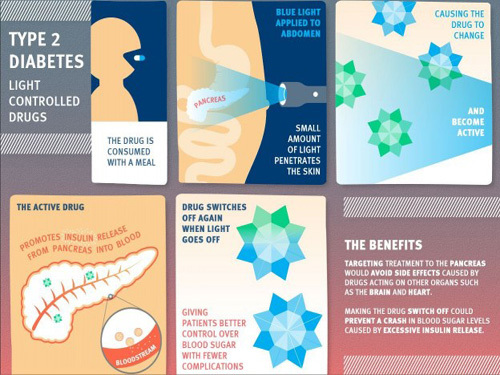
The use of drugs to adjust insulin in people with diabetes is a common way to control blood sugar, but it is often because the drug is too fierce to make blood glucose transiently too low, or it may cause damage to the brain or heart. Scholars have studied the use of blue LEDs to irradiate medicines in the body so that they can be turned "on" or "off", and they can regulate insulin in a more precise way and reduce harm to the body. The study was published in the journal Nature Communications.
The study was jointly developed by the Imperial College London, England, and the University of Munich, Germany. They modified a drug "Sulfonylurea," which is already in use, so that it could change shape through blue LED illumination, that is, After the diabetic patient eats the modified drug JB253, it will not have an immediate effect (upper left in the figure above). When he takes the blue LED onto the skin (above in the image above), it will change the shape of the drug (above right ), And start the drug began to stimulate the body to release insulin, when the LED light turned off, the drug returned to its original shape, it will stop working (in the figure below).
David Hodson, MD, MD, PhD, of the Imperial College School of Medicine, said that in addition to regulating how much insulin is switched on and off, this approach can also reduce some complications by allowing the drug to start functioning on a specific part of the body, such as the pancreas (bottom left). . He also emphasized that this study is still an early stage, and it will take some time before it can truly develop the available therapies.
During the mid 1970s, researchers developed a maintenance-free lead-acid Battery that can operate in any position. The liquid electrolyte is gelled into moistened separators and the enclosure is sealed. Safety valves allow venting during charge, discharge and atmospheric pressure changes.
Driven by different market needs, two lead-acid systems emerged: The small sealed lead-acid (SLA), also known under the brand name of Gelcell, and the larger Valve-regulated-lead-acid (VRLA). Both batteries are similar. Engineers may argue that the word 'sealed lead-acid' is a misnomer because no rechargeable battery can be totally sealed.
Unlike the flooded lead-acid battery, both SLA and VRLA are designed with a low over-voltage potential to prohibit the battery from reaching its gas-generating potential during charge because excess charging would cause gassing and water depletion. Consequently, these batteries can never be charged to their full potential. To reduce dry-out, sealed lead-acid batteries use lead-calcium instead of the lead-antimony.
The optimum operating temperature for the lead-acid battery is 25°C (77°F). Elevated temperature reduces longevity. As a guideline, every 8°C (15°F) rise in temperature cuts the battery life in half. A VRLA, which would last for 10 years at 25°C (77°F), would only be good for 5 years if operated at 33°C (92°F). The same battery would desist after 2½ years if kept at a constant desert temperature of 41°C (106°F).
The sealed lead-acid battery is rated at a 5-hour (0.2) and 20-hour (0.05C) discharge. Longer discharge times produce higher capacity readings because of lower losses. The lead-acid performs well on high load currents.
Smf Motorcycle Battery,Electric Vehicle Batteries,conventional Motorcycle Battery,Maintenance Free Motorcycle Battery With Acid Pack
Starlight Power Industrial Company Limited , https://www.starlite-power.com